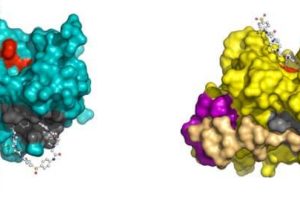national synchrotron light source
Shortest-pulse X-ray beams could illuminate atomic, molecular interactions
ANN ARBOR, Mich.—Ultra-short X-ray beams produced at the University of Michigan could one day serve as more sensitive medical diagnostic tools, and they could work like strobe lights to allow researchers to observe chemical reactions that happen…
New highly stable fuel-cell catalyst gets strength from its nano core
UPTON, NY – Stop-and-go driving can wear on your nerves, but it really does a number on the precious platinum that drives reactions in automotive fuel cells. Before large fleets of fuel-cell-powered vehicles can hit the road, scientists will have to…
Key difference in how TB bacteria degrade doomed proteins
UPTON, NY — Scientists at the U.S. Department of Energy’s (DOE) Brookhaven National Laboratory and Stony Brook University have discovered a key difference in the way human cells and Mycobacterium tuberculosis bacteria, which cause TB, deliver unw…
Scientists Image Soft Tissues With New X-Ray Technique
Scientists at the U.S. Department of Energy’s Brookhaven National Laboratory, in collaboration with researchers at Rush Medical College, have demonstrated the effectiveness of a novel x-ray imaging technology to visualize soft tissues of the human foot that are not visible with conventional x-rays. The technique, called Diffraction Enhanced Imaging (DEI), provides all of the information imparted by conventional x-rays as well as detailed information on soft tissues previously accessible only with additional scanning methods such as ultrasound or magnetic resonance imaging (MRI). This study appears in the May 2003 issue of the Journal of Anatomy.
Scientists Use Light to Determine Structure of Heterogeneous Surfaces
Scientists have refined a technique that uses very intense light to determine the structure of chemically heterogeneous surfaces with a submillimeter resolution. The description of the technique and its application to the study of varying densities of surface-bound molecules – each about one thousand times smaller than the diameter of a human hair – appears as the cover story of the January 13, 2003, issue of Applied Physics Letters. “Surfaces with gradually varying structures are being investigated by academia and industry for their potential uses in creating cleaner energy sources, designing chemical and biological sensors, and creating molecular patterns,” said Jan Genzer, a chemical engineer at North Carolina State University in Raleigh and the lead author of the study. “By determining the chemical structure of surfaces covered with films as thin as a few billionths of a meter, scientists and engineers can improve their properties and performance.”
New Technique Reveals Structure of Films With High Resolution
Scientists have developed and tested a new imaging technique that reveals the atomic structure of thin films with extremely high resolution. For the first time, the technique has shown very precisely how the atoms of the first layers of a film rearrange under the action of the substrate on which the film is grown. Thin films are currently used in technologies including electronic chips, coatings, and magnetic recording heads. To improve the properties of these materials and create even thinner structures ? such as smaller electronic chips ? scientists are now trying to understand how the films interact with the substrate on which they are grown.

